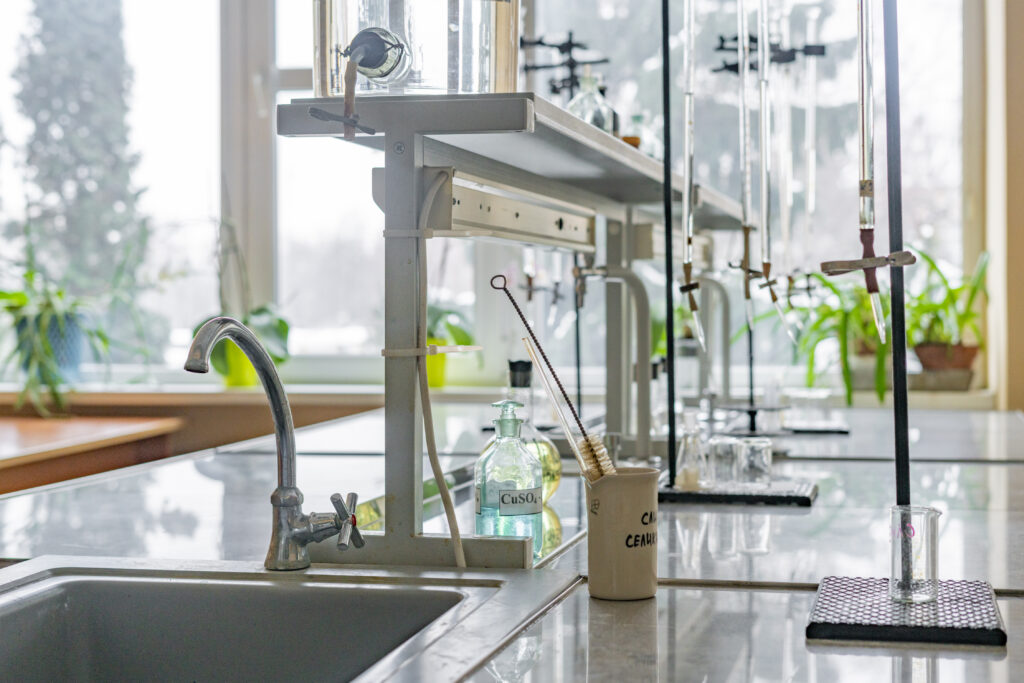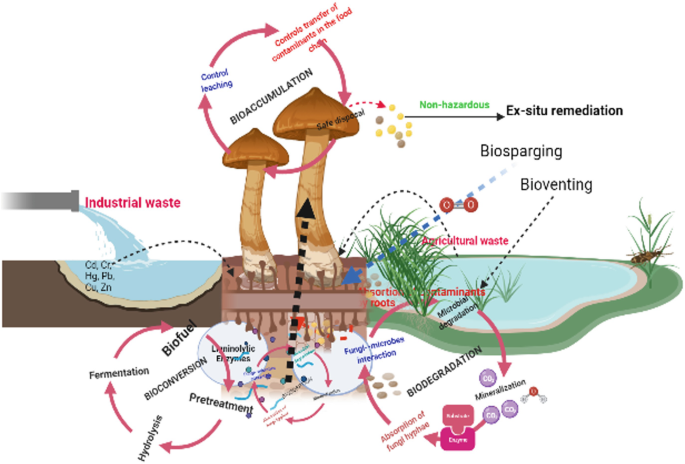
The Mushroom Magic: Mycoremediation And How It Helps Reduce Environmental Pollutants
In a world grappling with pollution and environmental degradation, mycoremediation steps in as a promising solution. This process uses the natural power of fungi—especially resilient species like oyster mushrooms—to break down harmful pollutants and restore ecosystems.
The secret lies in their unique ability to digest toxins, transforming them into harmless byproducts. This offers a sustainable, low-cost approach to cleaning up the environment, with fungi acting as nature’s own recyclers.
As the benefits of mycoremediation gain wider recognition, it’s clear that mushrooms are more than just fascinating fungi—they’re essential partners in revitalizing our planet.
From Liquid Cultures to Solutions: The Science Behind Mycoremediation
Mycoremediation, a term coined by renowned mycologist Paul Stamets, is the science of deploying fungi to degrade or fully eliminate pollutants and harmful substances in the environment. Fungi are nature’s recyclers: their primary behavior in the ecosystem is to decompose waste substances and convert them into nutrient-rich soil.

How Does Mycoremediation Work?
The brilliance behind mycoremediation lies within the biological makeup of fungi specifically the mycelium—a web-like network of fine fungal filaments. Mycelium produces powerful enzymes that can break down a vast range of substances, including stubborn pollutants like heavy metals, oil, pesticides, and even plastics. Among these enzymes, lignin peroxidase and manganese peroxidase are particularly crucial, capable of acting on complex molecules that most other organisms can’t touch.
Turning the Tide: How Mushrooms Helped Heal Polluted Sites
The Bodo Oil Spill: A Turning Point
A prime example of mycoremediation in action occurred after the Bodo Oil Spill in Nigeria in 2008. The massive oil release caused extensive damage to local ecosystems. But with the introduction of oyster mushrooms to the contaminated soil, things began to change. The fungi got to work, breaking down the oil’s hydrocarbons and significantly reducing pollution levels. Soon enough, the cleaned land was safe for new plant growth, breathing life back into the affected area.
Purifying Water with Oyster Mushrooms in Chicago
Another remarkable demonstration of mycoremediation’s potential took place in efforts to address the long-standing pollution of the Chicago River. Since the 1700s, the river has accumulated various contaminants, making water quality a persistent challenge. To explore a natural solution, a lab-based study tested the ability of oyster mushrooms (Pleurotus ostreatus) to purify water.
Researchers used oyster mushroom mycelia on E. coli-contaminated water, both in lab-prepared samples and directly from the Chicago River. The results were impressive: within 96 hours, the mycelium managed to remove 99.25% of E. coli in the lab sample and 99.74% from the river water.
The Future of Environmental Cleanup
These real-world stories showcase the incredible power of mycoremediation to combat pollution. With their natural ability to break down even the toughest contaminants, fungi offer a sustainable and innovative solution for restoring damaged ecosystems.
The Common Types of Mushrooms Making a Difference in Pollution Control
Certain mushrooms stand out for their ability to help clean up polluted environments, using their natural properties to break down toxins, filter contaminants, and restore balance to ecosystems. Below, we explore some of the most effective mushrooms used in mycoremediation, each with its unique role in this natural cleanup process.
Oyster Mushrooms (Pleurotus ostreatus)
Often called the “workhorse” of mycoremediation, oyster mushrooms are incredibly versatile and resilient. Their key attributes include:
- Rapid Growth: These mushrooms grow quickly, allowing for swift deployment in contaminated areas.
- Adaptability: They thrive in various environments, from forests to urban landscapes, making them suitable for diverse remediation projects.
- Versatility: Oyster mushrooms are known for breaking down a wide range of pollutants, including hydrocarbons, heavy metals, and pesticides.
Turkey Tail (Trametes versicolor)
Turkey Tail mushrooms are named for their colorful, fan-shaped caps resembling a wild turkey’s tail. In mycoremediation, their strengths lie in:
- Breaking Down Organic Pollutants: Turkey Tail is highly effective in decomposing lignin and other wood-based substances.
- Potential for Broader Applications: Studies are exploring its capacity to help degrade various environmental toxins beyond just wood, such as in wastewater, extending its usefulness in remediation projects.
King Stropharia (Stropharia rugosoannulata)
Known as the “garden giant,” King Stropharia brings unique benefits to mycoremediation, particularly in:
- Water and Soil Filtration: This mushroom excels at filtering contaminants from both water and soil, making it valuable for wetland restoration and agricultural runoff management.
- Enhancing Soil Health: In addition to filtering pollutants, King Stropharia contributes to enriching soil by adding organic matter as it grows.
White Rot Fungi (Phanerochaete chrysosporium)
White Rot Fungi are especially notable for their ability to break down complex pollutants. Their strengths include:
- Lignin Degradation: They excel at breaking down lignin, a major component of wood, which allows them to tackle a range of organic pollutants.
- Powerful Toxin Degradation: White Rot Fungi can degrade some of the most challenging environmental toxins, including certain pesticides and industrial chemicals, making them highly effective in severe contamination cases.
These fungi are essential players in mycoremediation, each offering unique capabilities to help clean up our environment.
Mycoremediation for a Cleaner Future: Impact, Benefits, and the Path to Environmental Recovery
Mycoremediation offers a promising path toward a cleaner future by harnessing the natural abilities of fungi to break down pollutants. This approach not only cleans up contaminated environments but also brings lasting benefits for ecosystems, paving the way for sustainable environmental recovery.
The Limitations of Traditional Cleanup Methods
Conventional methods for environmental cleanup often come with significant drawbacks:
- Harsh Chemicals and Disruption: These approaches may involve the use of chemicals or processes that can further harm the environment and disrupt delicate ecosystems.
- Incomplete Pollutant Removal: Even after cleanup, toxic residues may remain, posing ongoing risks to health and nature.
- High Costs and Energy Use: Many traditional methods are both costly and energy-intensive, making them less sustainable for long-term pollution management.

Mycoremediation: Nature’s Solution to Pollution
Unlike traditional approaches, mycoremediation taps into nature’s own abilities for pollution control. Using certain mushrooms in mycoremediation can significantly reduce toxic pollutants in soil, water, and air. By breaking down harmful substances, these fungi not only clean up existing contaminants but also enhance soil fertility, creating a healthier ecosystem for plants, insects, and animals. Their role in carbon sequestration further contributes to the fight against climate change.
Moreover, the fibrous mycelium network of these mushrooms can trap and filter pollutants from stormwater runoff, which is a major source of water pollution. This capability makes them valuable for improving water quality, particularly in urban areas. The environmental benefits of mycoremediation with fungi are therefore multi-faceted: reducing pollution, enriching soil, enhancing water quality, and aiding in carbon capture.
Be Part of the Solution: How You Can Help Drive Environmental Change
Supporting mycoremediation is not just for scientists and researchers—there are plenty of ways you can get involved in this natural approach to cleaning up our planet. By taking small actions and spreading awareness, you can play a role in driving environmental change and fostering a healthier ecosystem.
- Support Mycoremediation Research: Donate to or collaborate with organizations and universities conducting mycoremediation studies. Your support can help fund essential research to further develop these eco-friendly solutions.
- Buy Mushrooms for Research Projects: If you’re involved in environmental research, choose fungi suppliers like us at Royal Mycology, who specialize in providing high-quality mushrooms for scientific projects focused on pollution control.
- Raise Awareness: Share information about the benefits of mycoremediation and fungal solutions with your community. The more people know about this natural approach, the more support it will gain.
- Get Involved in Local Cleanup Projects: Participate in environmental restoration efforts that incorporate mycoremediation. Some community initiatives may already be using fungi to remediate contaminated areas.
- Advocate for Eco-Friendly Policies: Push for policies that encourage sustainable remediation techniques, including mycoremediation, as part of environmental cleanup standards.
Remember, each step, no matter how small, matters. A greener, healthier planet is a collective effort, and you, as a consumer, have an important part to play. Don’t underestimate the ripples of change you can initiate by becoming more mushroom-minded!
Partnering for a Greener Future: How Royal Mycology Makes a Difference
Throughout this article, we’ve explored the remarkable potential of mycoremediation to tackle environmental challenges. By utilizing fungi like oyster mushrooms to break down pollutants and restore ecosystems, mycoremediation offers a sustainable, nature-based solution for cleaning up our planet.
At Royal Mycology, we’re dedicated to driving progress in this field by providing premium fungi for research that advances these eco-friendly practices. We’re committed to helping researchers and innovators harness the power of fungi for a cleaner, healthier future.
If you’re interested in contributing to this mission or learning more about how you can get involved, connect with us on Instagram. Reach out and discover how our fungi can play a role in your research, projects, or sustainability efforts!
FAQs
How does mycoremediation differ from traditional cleanup methods?
Mycoremediation utilizes fungi to break down pollutants naturally, whereas traditional methods often involve harsh chemicals and machinery.
How do mushrooms clean up pollutants?
Mushrooms produce enzymes that break down toxins into simpler, less harmful substances. Their mycelium, a network of root-like structures, absorbs and traps these pollutants, gradually detoxifying the environment.
What types of mushrooms are commonly used in mycoremediation?
Oyster mushrooms, Turkey Tail, King Stropharia, and White Rot Fungi are popular choices. These mushrooms are known for their rapid growth, adaptability, and ability to break down a range of contaminants.
Is mycoremediation safe for the environment?
Yes, mycoremediation is considered a safe and natural method. Since fungi are already part of ecosystems, they help restore balance without introducing harmful chemicals or disrupting local wildlife.
Can mycoremediation be used for water pollution?
Absolutely! Certain fungi can filter out contaminants from water sources. The mycelium acts like a sponge, trapping and degrading pollutants, making it a valuable tool for improving water quality.




